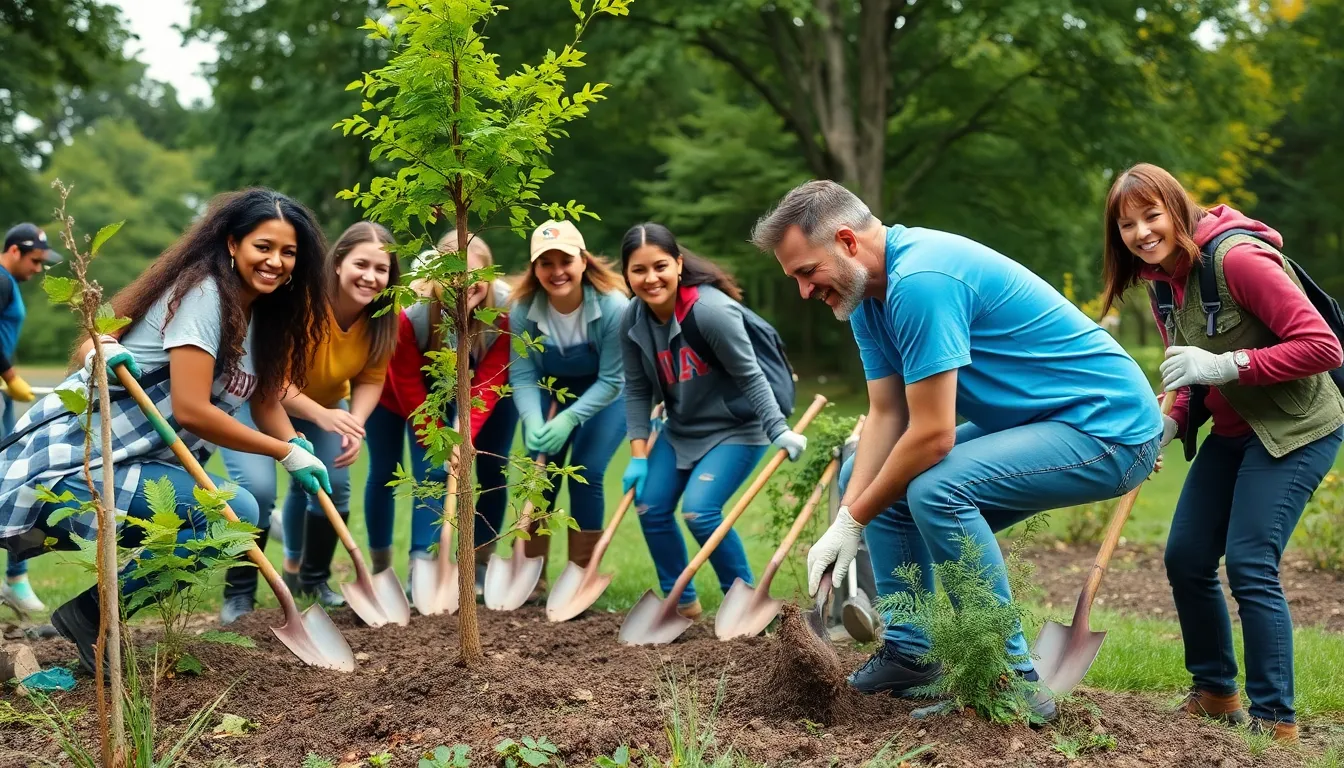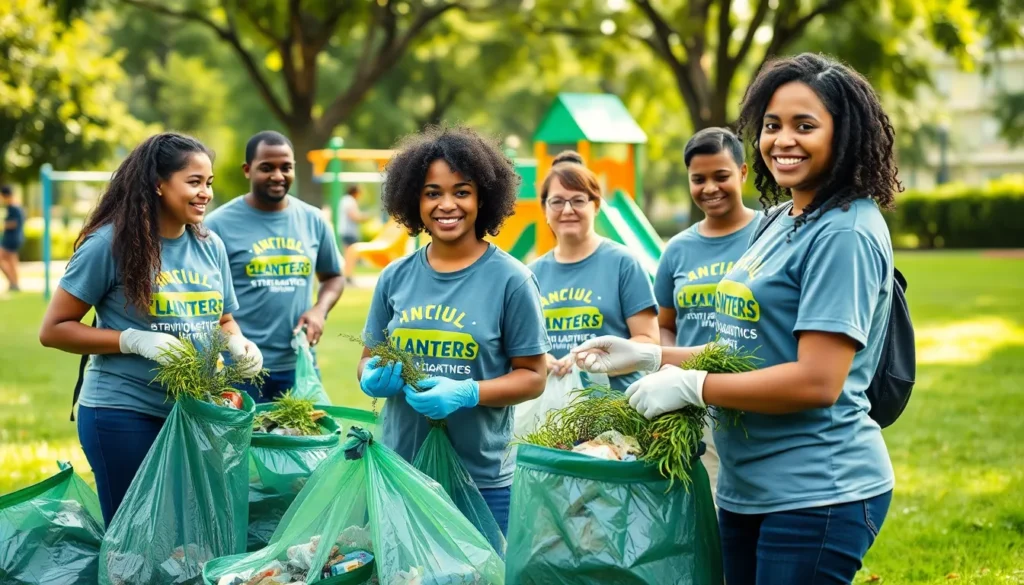Table of Contents
ToggleCommunity service plays a vital role in shaping strong, connected neighborhoods. It fosters a sense of belonging and encourages individuals to contribute positively to the world around them. By engaging in volunteer work, people not only uplift their communities but also gain valuable experiences that enrich their lives.
Participating in community service opens doors to new friendships and networks while addressing pressing social issues. Whether it’s helping at a local food bank or organizing a neighborhood cleanup, these acts of kindness create lasting impacts. As more individuals recognize the importance of giving back, the ripple effect of their efforts can lead to transformative change in society.
What Is Community Service?
Community service comprises voluntary activities aimed at improving local communities or addressing social issues. It includes efforts such as assisting at shelters, cleaning public spaces, tutoring students, or organizing food drives. Individuals or groups participate without monetary compensation, focusing instead on making a positive impact.
Community service fosters personal growth and enhances community welfare. Engaging in these activities cultivates skills like leadership, teamwork, and empathy. Through these experiences, volunteers often develop a deeper understanding of social challenges, benefiting both themselves and those they help.
Participation in community service can occur through numerous channels. Schools often require students to fulfill service hours, while organizations may encourage employees to volunteer as part of corporate social responsibility initiatives. The collaborative nature of these efforts creates opportunities for networking and building friendships, strengthening community ties.
Community service plays a vital role in creating a supportive environment. It not only addresses immediate needs within neighborhoods but also empowers residents to advocate for change. Engaging in community service fosters a spirit of cooperation, ensuring sustainable development and improved quality of life for all.
Benefits of Community Service

Community service offers numerous advantages, both for individuals and the broader society. Engaging in these activities promotes personal development and creates significant positive changes in local communities.
Personal Growth
Community service promotes personal growth by enhancing essential skills. Volunteering cultivates leadership abilities, improves teamwork dynamics, and fosters empathy. Participants often gain confidence through hands-on experiences, learning to communicate effectively and navigate challenges. Additionally, involvement in community service encourages individuals to broaden their perspectives, as they interact with diverse populations and immerse themselves in different environments. As a result, individuals may discover new passions and career paths while enhancing their resumes.
Community Impact
Community service directly influences the welfare of neighborhoods and social structures. It addresses pressing social issues like hunger, homelessness, and environmental concerns. Projects often lead to revitalized public spaces, increased access to essential services, and strengthened social networks. For example, food drives and tutoring programs not only meet immediate needs but also empower residents through education and resources. Collective actions create a sense of belonging, enabling communities to unite for common goals, thereby promoting long-term improvements and sustainability.
Types of Community Service
Community service encompasses various forms of volunteer work that individuals can engage in to support their communities. Two prominent types include participation in volunteer organizations and involvement in sponsored events.
Volunteer Organizations
Volunteer organizations provide structured opportunities for individuals to contribute toward specific causes or needs. Examples of these organizations include:
- Food Banks: They collect and distribute food to those in need, relying on volunteers for sorting, packaging, and delivering supplies.
- Animal Shelters: They require volunteers for tasks such as feeding, walking, and caring for animals awaiting adoption.
- Youth Programs: Organizations like Boys & Girls Clubs involve volunteers in tutoring and mentoring children and teenagers, helping them develop life skills.
- Environmental Groups: These groups mobilize volunteers for initiatives like tree planting, habitat restoration, and clean-up events in parks and rivers.
Sponsored Events
Sponsored events create opportunities for community members to participate while often raising funds or awareness for specific initiatives. Common types include:
- Charity Runs or Walks: These events encourage participants to raise funds by securing sponsorships while promoting physical activity and community health.
- Fundraising Drives: Local businesses or schools may host drives to collect donations for specific causes, such as supporting local shelters or funding community projects.
- Workshops and Classes: Sponsored educational events can provide free skills training in areas like job readiness, health awareness, or sustainability practices while allowing individuals to gain valuable knowledge.
- Festivals and Fairs: Community gatherings often feature local artisans and vendors, with proceeds supporting local charities or community projects.
By engaging in these types of community service, individuals contribute to the betterment of their neighborhoods while fostering connections and support systems within the community.
How to Get Involved
Community members can engage in various ways to contribute positively to their neighborhoods. Finding and committing to community service opportunities fosters personal growth and strengthens social bonds.
Finding Opportunities
Finding community service opportunities involves researching local organizations and events. Individuals can visit websites of local nonprofits, libraries, and community centers for listings of volunteer activities. Joining social media groups dedicated to community initiatives often leads to discovering nearby projects. Participating in community meetings provides insights into current needs and opportunities. Online platforms, such as VolunteerMatch and Idealist, connect volunteers with organizations seeking assistance. Additionally, schools and workplaces often promote volunteer programs, providing structured involvement options.
Making a Commitment
Making a commitment to community service requires dedication and consistency. Individuals should assess their interests and skills to identify suitable activities. Setting a specific schedule for volunteering helps maintain consistency and encourages accountability. Communicating with organizations about available roles ensures alignment between personal strengths and community needs. Exploring long-term projects rather than one-time events often yields greater impact and fosters deeper connections. Discussing expectations with fellow volunteers further enhances teamwork and encourages collaborative efforts toward common goals.
Challenges in Community Service
Community service, while rewarding, faces several challenges that can hinder effective engagement. Understanding these challenges can help individuals and organizations develop strategies to address them.
Limited Resources
Limited resources often restrict community service initiatives. Organizations may struggle with insufficient funding, inadequate manpower, or a lack of essential materials. This scarcity undermines project execution and can lead to unmet community needs.
Volunteer Recruitment and Retention
Recruiting and retaining volunteers poses another significant challenge. High turnover rates reduce program continuity and effectiveness. Factors contributing to this issue include time constraints, lack of awareness, and limited motivation among potential volunteers.
Communication Gaps
Communication gaps can affect community service efforts. Misunderstandings regarding expectations, objectives, and responsibilities may arise between organizations and volunteers. Clear, consistent communication ensures everyone involved understands their roles and the overall mission.
Engaging Diverse Populations
Engaging diverse populations in community service can also be challenging. Cultural differences, language barriers, and differing community values impact participation. Tailoring approaches to inclusivity fosters strong connections and enhances project effectiveness.
Measuring Impact
Measuring the impact of community service initiatives remains complex. Organizations often struggle to quantify their contributions to community improvement. Establishing clear metrics and evaluation methods can help illustrate the value of efforts and secure further support.
Sustainability
Ensuring sustainability of community service projects presents an ongoing challenge. Many initiatives face obstacles in securing long-term funding or ongoing volunteer commitment. Building partnerships and developing strategies for sustained engagement can help address this concern.
Navigating Bureaucratic Barriers
Navigating bureaucratic barriers can hinder community service projects. Regulations, permits, or logistical challenges may delay or block initiatives. Understanding local policies and working with established agencies can streamline processes and facilitate smoother operations.
Addressing these challenges helps enhance the effectiveness and reach of community service efforts, ultimately benefiting neighborhoods and individuals involved.
Community service stands as a vital pillar in fostering connected and resilient neighborhoods. Through volunteering, individuals not only contribute to their communities but also experience personal growth and development. The relationships formed and skills gained during these activities can lead to lasting change.
Addressing challenges like resource limitations and communication barriers is essential for maximizing the impact of community service. By actively participating and supporting local initiatives, everyone can play a role in creating a more vibrant and inclusive society. Ultimately, the collective efforts of community members can drive meaningful progress and enhance the quality of life for all.







